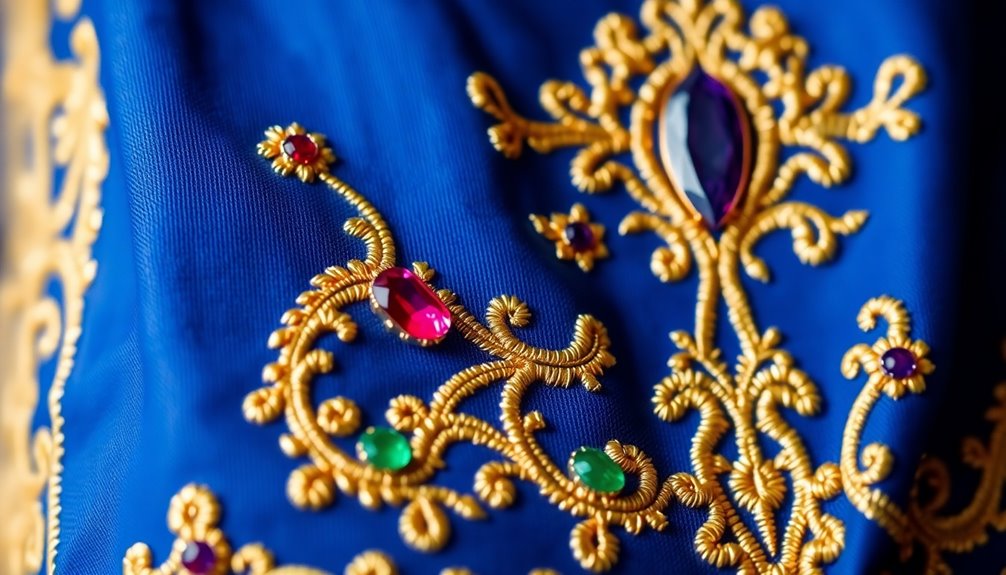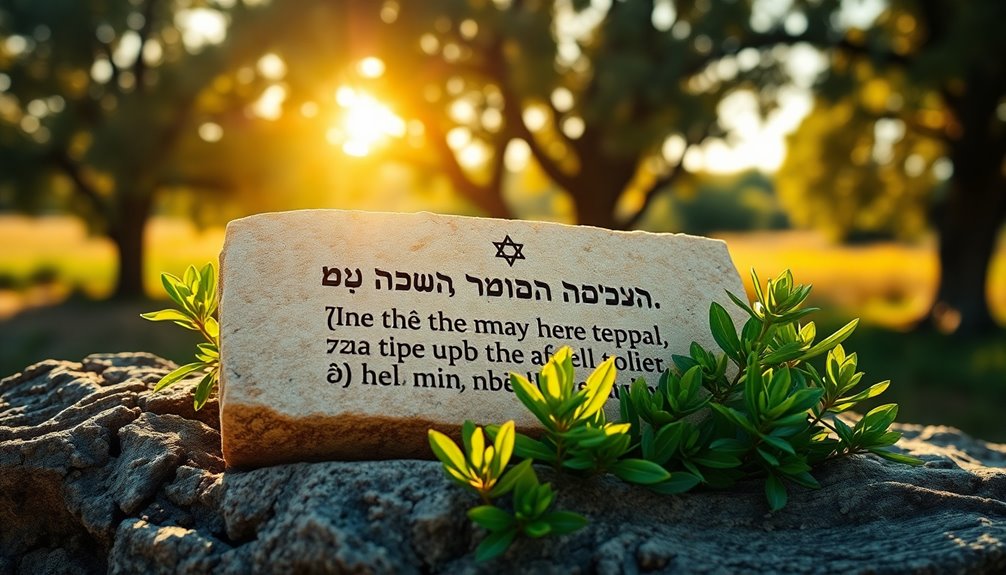The ephod is a ceremonial garment worn by the High Priest in ancient Israel. It symbolizes his role as a mediator between God and the people. Crafted with elaborate materials, the ephod aids in divine guidance during decision-making through the Urim and Thummim. It also features two onyx stones, each engraved with the names of the twelve tribes, representing their collective identity before God. This garment emphasizes the significance of proper worship and the priest's connection to divine authority. If you want to explore more about its historical context and spiritual implications, you'll find intriguing insights ahead.
Key Takeaways
- The ephod is a ceremonial garment worn by the High Priest in ancient Israel, symbolizing mediation between God and the people.
- It featured onyx stones engraved with the names of the twelve tribes, representing their collective identity before God.
- The ephod was integral in divine decision-making, used alongside the Urim and Thummim for seeking guidance.
- Its design included gold, blue, purple, scarlet threads, and fine linen, emphasizing the holiness of worship practices.
- Misuse of the ephod led to idolatry, illustrating the importance of properly understanding its sacred purpose.
Introduction
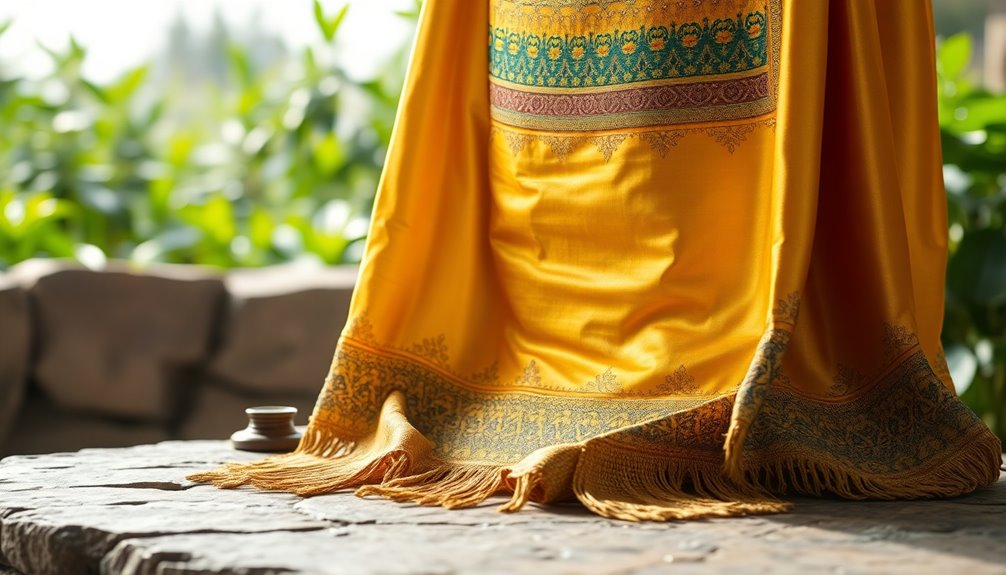
What role did the ephod play in ancient Israel? The ephod was a ceremonial garment worn by the High Priest, crafted from gold, blue, purple, scarlet threads, and fine linen. This exquisite priestly attire symbolized the High Priest's vital role as a mediator between God and the people of Israel.
Adorning the ephod were shoulder straps and ornamental attachments, making it not only functional but also visually striking.
Interestingly, the ephod had a dual significance. While it served as a sacred garment, it also became associated with idolatrous practices. For example, Gideon created an ephod that the Israelites later worshipped, demonstrating how easily the sacred can turn to the profane.
Moreover, the ephod played a crucial role in seeking divine guidance. The High Priest used it alongside the Urim and Thummim, a system of divination that allowed the Jewish leaders to consult God during critical decisions.
This connection to the Ark of the Covenant further emphasized the ephod's importance in the spiritual life of ancient Israel, making it a central element in the pursuit of divine will and guidance.
Biblical Significance of the Ephod
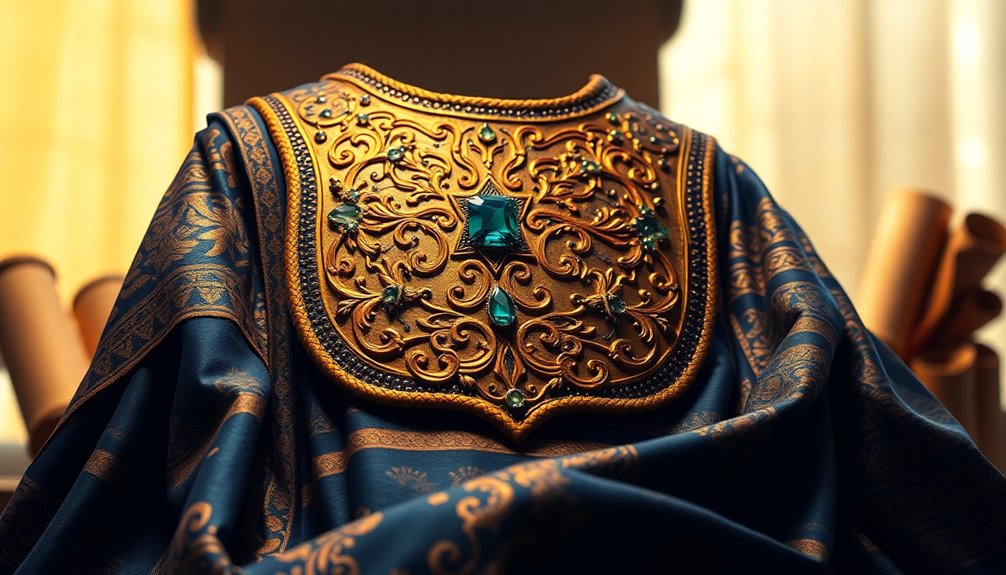
When you look at the biblical significance of the ephod, it's clear that its role goes beyond fashion; it embodies the high priest's connection to God and the people of Israel.
Key references in Exodus highlight its design and purpose, while secondary accounts illustrate its impact on worship and decision-making throughout Israel's history.
Understanding these points helps you appreciate the ephod's spiritual weight in biblical narratives.
Primary Bible References
The ephod holds profound significance in the Bible, serving as a vital symbol of the high priest's role and connection to God. This ceremonial garment, made of fine linen, gold, and colorful yarns, is explicitly described in Exodus 28:6. Its design includes shoulder pieces and a waistband adorned with golden rings, emphasizing the high priest's dignity and authority.
Notably, two onyx stones engraved with the names of the twelve tribes of Israel sit on the ephod, symbolizing their representation before God (Exodus 28:9-12). Figures such as Aaron, Samuel, and King David donned this sacred garment during worship (1 Samuel 2:18, 2 Samuel 6:14), highlighting its spiritual importance.
The ephod also served a crucial functional role, used alongside the Urim and Thummim to provide divine guidance and decision-making for the Israelites (1 Samuel 23:9).
However, it's essential to note that the ephod's significance was sometimes tarnished by idolatry, with instances of misuse as an object of worship (Judges 8:26-27). Thus, the ephod represents both a divine connection and a cautionary tale about the potential for misuse.
Secondary Bible References
Building on the vital role of the ephod in the high priest's attire, secondary references in the Bible further illuminate its significance. This ceremonial garment, crafted from fine linen and vivid colors, embodies holiness and divine service. The ephod's onyx stones, engraved with the names of the twelve tribes of Israel, symbolize the high priest's mediating role between God and His people, reinforcing the connection between sacred objects and spiritual identity (Exodus 28:9-12).
During significant events, like rituals and worship, the ephod was essential for the high priest, emphasizing its critical place in the religious practices of ancient Israel (Leviticus 8).
Moreover, the ephod wasn't just a beautiful garment; it was integral to oracular functions. When used with the Urim and Thummim, it enabled the high priest to seek divine guidance, showcasing Israel's reliance on these sacred objects for decision-making (1 Samuel 30:7).
These references highlight how the ephod served not only as part of the high priest's attire but also as a vital instrument in the spiritual practices of Israel, illustrating the evolving nature of their relationship with God.
Priestly Garments in Ancient Israel
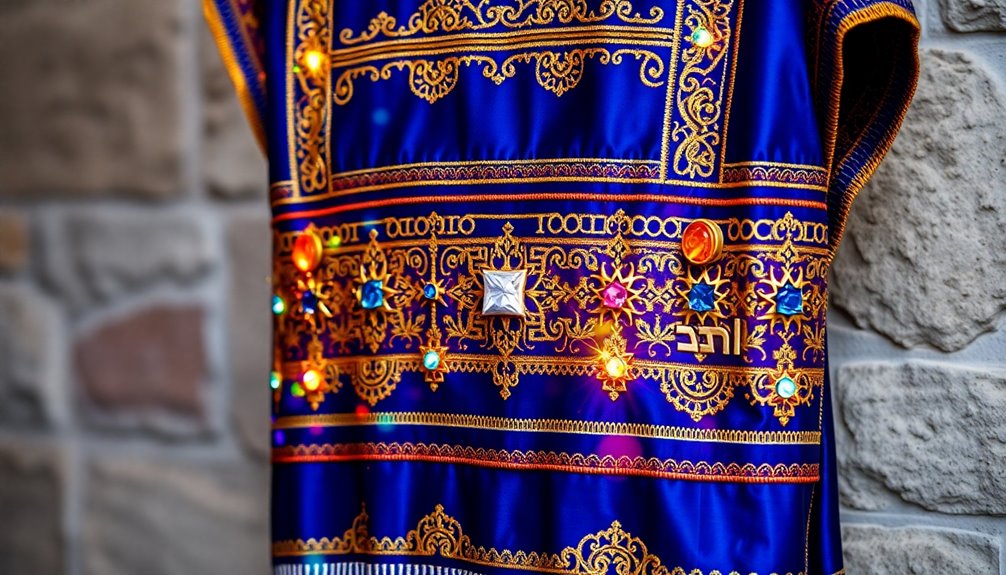
Priestly garments in ancient Israel played a crucial role in religious practices, symbolizing the connection between the divine and the community. The most significant of these garments was the ephod, a ceremonial garment worn by the high priest. Crafted from gold, blue, purple, scarlet threads, and fine linen, it featured two prominent shoulder pieces and a skillfully woven waistband. Engraved onyx stones adorned the ephod, bearing the names of the twelve tribes of Israel, highlighting the high priest's role in mediating between God and His people.
During significant religious ceremonies, the high priest donned the ephod to seek divine guidance, utilizing the Urim and Thummim, integral tools for discerning God's will.
Alongside the ephod, the high priest wore additional garments like the robe, tunic, and mitre, emphasizing the importance of proper attire in worship and adherence to priestly ordinances. While the high priest's ephod was elaborate, linen ephods were also worn by common priests and prophets, indicating varying levels of priestly significance within ancient Israelite religious practices.
Together, these garments reinforced the sacredness of worship and the necessity of approaching God with reverence.
Symbolism of the Stones

Worn on the shoulder pieces of the ephod, the two onyx stones carry deep symbolism in ancient Israelite worship. Each stone is engraved with the names of six tribes of Israel, highlighting the high priest's vital role in bearing the tribes before God. This engraving serves as a powerful representation of the Israelites' collective identity and their covenant relationship with the divine.
The onyx stones symbolize intercession, as the high priest acts as a mediator between God and the people. By wearing these stones, he brings the concerns and prayers of the tribes directly to God, reflecting their sacredness in worship. The use of precious onyx emphasizes the importance of the ephod and its components in ceremonial duties.
Moreover, the stones are integral to divine decision-making, especially when used alongside the Urim and Thummim. Together, they guide the high priest in communicating God's will to the people.
Through these onyx stones, not only is the high priest reminded of his responsibilities, but the tribes of Israel are also spiritually represented, reinforcing their connection to God and their shared mission as a chosen people.
Ephod's Role in Divination
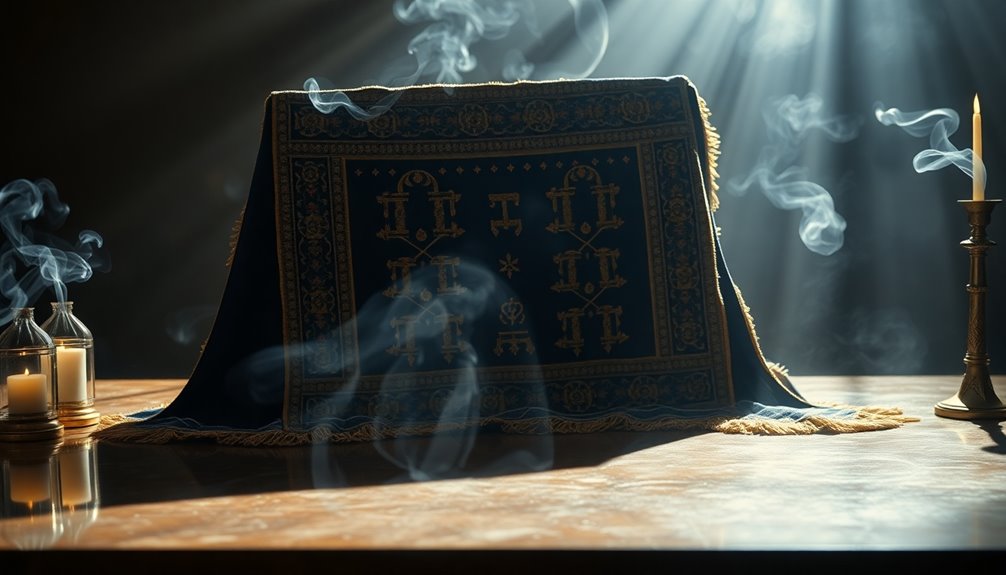
When you think about the ephod, it's easy to assume its role was strictly ceremonial, but that's a common misconception.
In reality, the ephod was crucial for divination, allowing priests to seek God's will during pivotal moments.
Understanding this function helps clarify how spiritual authority was interpreted in ancient Israelite culture.
Debunk Common Ephod Misconceptions
How often do people misunderstand the ephod's role in divination? Many think of it merely as a garment, overlooking its significant function in seeking divine guidance. The ephod, worn by the high priest, wasn't just fabric; it was a vital tool that included the Urim and Thummim. These sacred items allowed the high priest to consult God, particularly during crucial moments in Israel's history, as highlighted in historical books like 1 Samuel.
However, this connection to divination sometimes led to misconceptions. Some associate the ephod with idolatrous practices, like Gideon's creation of an idol from it, which muddied its sacred purpose. While it served holy functions, its misuse illustrated the duality of its role.
It's essential to recognize that the ephod was intended for sacred communication, not as an idol. The loss of prophetic guidance linked to the ephod, especially after Zechariah's death, marked a significant shift in how the Israelites connected with the divine.
Understanding this context helps clarify its true purpose, distancing it from mere idol worship and reaffirming its importance in divine consultation.
Misinterpretation of Spiritual Authority
The ephod, often misunderstood, played a crucial role in interpreting spiritual authority in ancient Israel. Used by priests, it was essential for seeking divine guidance through the Urim and Thummim. However, its connection to divination practices led to significant misinterpretation. When Gideon created an ephod that became an idol, it illustrated how easily the sacred can transform into a tool for idolatry.
As leaders like Saul and David consulted the ephod for direction, the potential for misguidance grew. When people began conflating the ephod with spiritual authority, they risked losing sight of its original purpose. The reliance on this ritual object for guidance sometimes overshadowed a direct relationship with God.
Historical texts and rabbinical literature highlight this shift, emphasizing the need for atonement for sins related to the misuse of the ephod. Ultimately, the misinterpretation of the ephod as a source of spiritual authority demonstrates the complexities of faith practices.
It serves as a cautionary tale about the delicate balance between seeking divine guidance and avoiding the pitfalls of idolatry. Understanding the ephod's true role helps clarify its significance in ancient Israel's spiritual landscape.
Daily Spiritual Guidance Practices

To receive daily spiritual guidance, you might consider incorporating prayer and reflection into your routine.
Group prayer sessions can also enhance your connection with others and deepen your understanding of God's direction in your life.
These practices echo the ancient use of the ephod, helping you stay attuned to divine insights.
Daily Prayer and Reflection
In seeking guidance through daily prayer and reflection, you can draw inspiration from the ancient practices surrounding the ephod. This sacred garment was used by priests to consult God, emphasizing the importance of intentional prayer in your spiritual practices. By engaging in daily prayer that mirrors these rituals, you can seek divine guidance similar to how priests utilized the Urim and Thummim for decision-making.
Incorporating elements of the ephod into your prayer space can enhance your connection to sacred traditions. Consider the colors and materials of the ephod as symbols that represent your journey and intentions. Reflecting on the ephod's role as a mediator can inspire you to adopt a similar approach in your life, promoting intercession and advocacy through your prayers.
As you engage in daily worship, allow the historical and spiritual context of the ephod to reinforce your sense of community with ancient practices. Each prayer becomes a bridge connecting you to those who sought guidance before you.
Group Prayer Sessions
Regularly participating in group prayer sessions can significantly deepen your spiritual journey, as they foster a sense of community and shared purpose. When you engage in these sessions, you enhance your collective spiritual experiences, allowing everyone to share their intentions and seek divine guidance together. This connection not only strengthens your bond with others but also encourages you to stay committed to your spiritual practices.
Structured around specific themes like forgiveness, gratitude, or guidance, group prayer sessions help you focus your intentions and prayers. Incorporating scripture or inspirational readings can deepen the experience, providing a solid foundation for shared reflections and insights. You'll find that these elements inspire growth and understanding among participants.
Establishing a routine of regularly scheduled group prayer sessions promotes ongoing spiritual growth. As you connect with others in your community, you become more accountable to one another, reinforcing your commitment to your spiritual journey.
Ephod's Enduring Spiritual Relevance
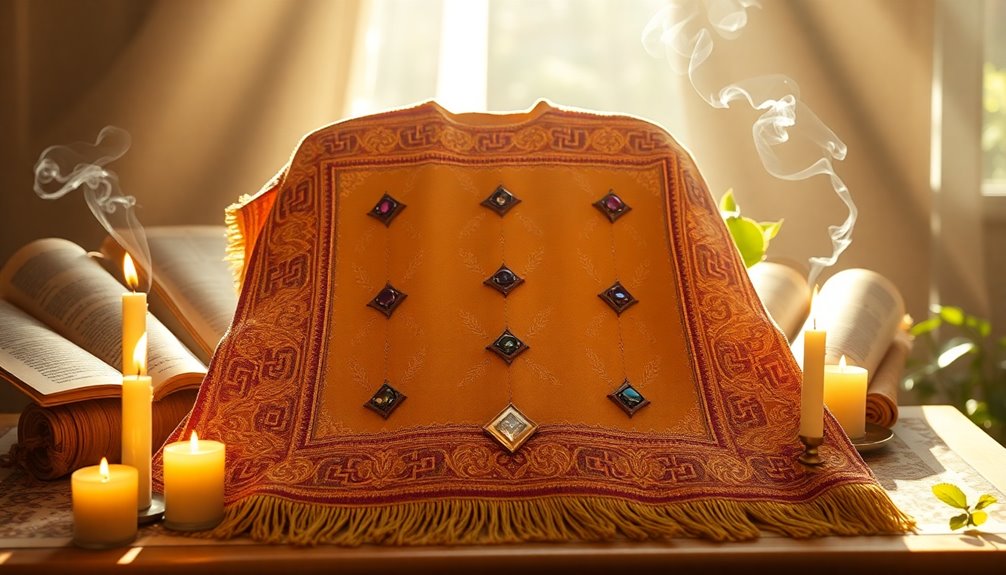
The ephod stands not just as a ceremonial garment but as a profound symbol of the high priest's unique role in connecting the people of Israel with God. Its intricate design, crafted from precious materials, highlights the importance of holiness in worship. The onyx stones, representing the collective sins of the Israelites, serve as a powerful reminder of their need for atonement and their covenant relationship with God.
In moments of crisis, the ephod facilitated divine guidance through the Urim and Thummim, showcasing its integral role in seeking God's will. This underscores the spiritual significance of the ephod, emphasizing the necessity of consecration before approaching the Divine. The rituals associated with the ephod reflect sacred practices aimed at maintaining purity and devotion.
However, the later association of the ephod with idolatry in Israelite history serves as a cautionary tale. It warns against blending sacred practices with unfaithfulness, reminding you that true worship requires sincerity and commitment.
Ultimately, the ephod remains a poignant symbol of your spiritual journey, inviting you to reflect on your relationship with God and the importance of atonement in your life.
Additional Resources
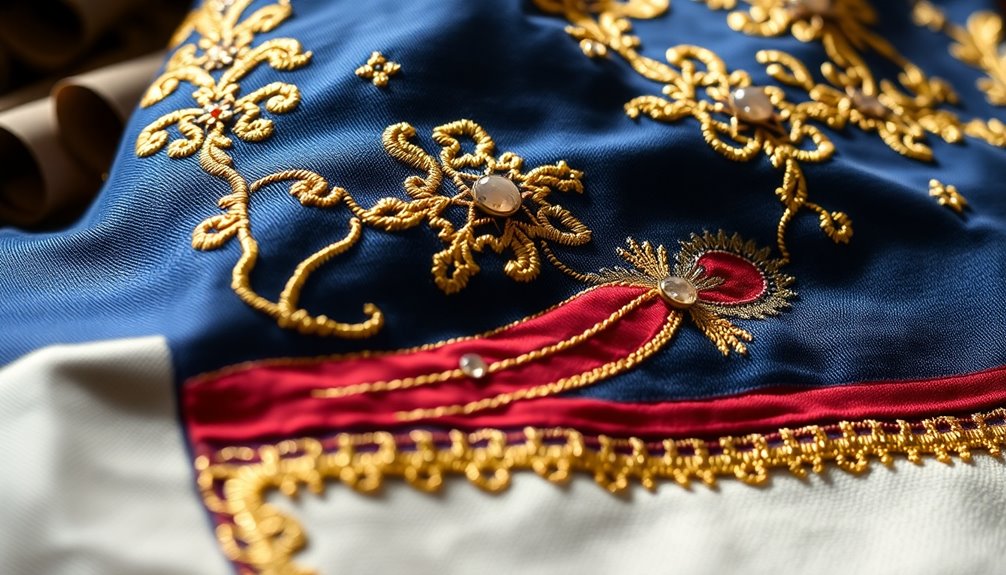
For those looking to deepen their understanding of the ephod and its significance, a variety of resources are available. Start with the Bible, particularly Exodus 28, where you'll find detailed descriptions of the ephod as a ceremonial garment worn by the high priest. This passage outlines its construction using gold, blue, purple, scarlet threads, and fine linen, along with the engraved onyx stones representing the twelve tribes of Israel.
You can also explore Talmudic references that delve into the ephod's role in priestly functions and its importance in mediating between God and the people.
Additionally, consider studying the instances of idol-like images associated with the ephod, as seen in the narratives of Gideon and Micah in Judges 8 and 17. These stories illustrate the dual meaning of the ephod in religious contexts.
Lastly, look for academic articles or commentaries that discuss the use of the ephod alongside the Urim and Thummim for seeking divine guidance in ancient Israel. Together, these resources will provide a well-rounded perspective on the ephod's multifaceted significance.
Frequently Asked Questions
What Does Ephod in the Bible Mean?
When you think about the significance of garments in ancient rituals, the ephod stands out.
It's a unique ceremonial outfit worn by the high priest, symbolizing a deep connection to God. You'll notice its intricate design, made with vivid colors and precious materials, representing holiness.
It's not just about appearance; the ephod served as a tool for divine communication, emphasizing the high priest's pivotal role in mediating between God and the people.
What Does a Biblical Ephod Look Like?
When you imagine a biblical ephod, think of a richly adorned garment made from gold, blue, purple, and scarlet threads, along with finely twisted linen.
It's designed with two shoulder pieces that fasten over the shoulders and a woven waistband for support.
The ephod boasts two onyx stones engraved with the names of the twelve tribes of Israel, and it features a square breastplate that holds the Urim and Thummim for divine guidance.
Why Did Gideon Make an Ephod?
Gideon made an ephod to celebrate Israel's victory over the Midianites and to honor his leadership.
You can see it as a way for him to commemorate their newfound freedom and unity.
However, it quickly turned into something problematic, as the people began to worship it rather than God.
This shift in focus highlights how easily symbols can lead you away from true faith and into idolatry.
Why Did David Put on the Ephod?
When David put on the ephod, he sought divine guidance during crucial moments, especially while transporting the Ark of the Covenant.
You can see that this act showcased his commitment to worship and his reliance on God's direction.

